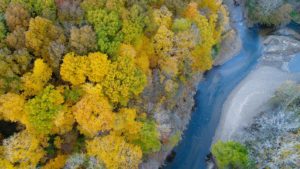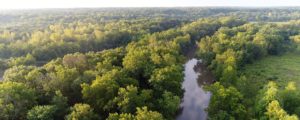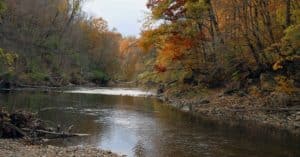Victory for the Middle Fork
By Andrew Rehn
The Middle Fork is one big step closer to being a well-protected river. On June 22nd of this year, the State of Illinois announced that it was suing Dynegy for pollution caused by their three coal ash ponds along the Middle Fork of the Vermilion River. The same day, the State filed an agreement with Dynegy that the company would propose a plan that includes removal of all three coal ash ponds from the floodplain of the river. This marks the first time in Illinois that Dynegy has agreed to close an ash pond by removal, and it is the first site in many years to propose such a plan.

The State’s agreement has Dynegy proposing a closure plan through Illinois’ new coal ash rules, created by the Coal Ash Pollution Prevention Act, which was finalized in April of this year. The first step in that closure process involves the company presenting a closure plan at a public meeting. The agreement requires Dynegy to hold that meeting on or before December 17, 2021. After the meeting, Dynegy will propose the plan to the Illinois Environmental Protection Agency who will review the plan, hold a comment period and public hearing, decide on the plan, and publish a response to the public’s comments with their decision. If all goes well, Dynegy will then begin removing the coal ash.
The agreement also requires some interim protections – and here Prairie Rivers Network and our partners at Eco-Justice Collaborative and Earthjustice will continue to be vigilant. Dynegy has to begin de-watering the coal ash, which is a necessary step before beginning removal. The dewatering process will require a modification to Dynegy’s NPDES permit which has its own set of environmental concerns as the water removed from the coal ash will be contaminated and will need to be disposed of safely.
Another interim protection required by the agreement is a water collection trench between the coal ash ponds and the river. We do not have many details at this point, but such a plan will likely require approvals from the Army Corps, the National Park Service, and the Illinois EPA. We will be tracking those details as they emerge and ensuring that any proposed plan is installed in a protective manner.
Lastly, the interim agreement has Dynegy reporting on erosion at the site monthly to ensure that the ponds are stable. Dynegy will have to prepare an emergency action plan for protecting the river bank should failure become imminent. Similar to the bank armoring proposal from a few years ago, this will require approval from multiple agencies, and we want to ensure that any protection is constructed in a way that does not leave a permanent scar on the river – especially now that full removal is on the horizon.
A Story Decades in the Making
Prairie Rivers Network and its members have long cherished the Middle Fork of the Vermilion River for its beauty, its ecological diversity, and its importance as a place to reconnect to the natural world. The following article which appeared in the Spring 2018 PRN newsletter is being republished and updated in this edition because the hard fought victory that we and our partners have achieved this year warrant a retelling of the fight for the Middle Fork.
 The fight for the Middle Fork has been decades-long, and without the tireless work of many folks who have stood up for the river, we would not have it today. In January 2018, PRN took steps in protecting Illinois’ only National Scenic River by announcing our intention to sue Dynegy for ongoing pollution of the Middle Fork. The coal ash at Dynegy’s closed Vermilion Power Station has been polluting the river for decades, and we have been looking to put a stop to that and permanently protect the river for generations to come.
The fight for the Middle Fork has been decades-long, and without the tireless work of many folks who have stood up for the river, we would not have it today. In January 2018, PRN took steps in protecting Illinois’ only National Scenic River by announcing our intention to sue Dynegy for ongoing pollution of the Middle Fork. The coal ash at Dynegy’s closed Vermilion Power Station has been polluting the river for decades, and we have been looking to put a stop to that and permanently protect the river for generations to come.
The Effort to Stop the Dam
In 1966, the land that would become the Middle Fork State Fish & Wildlife Area was on the Army Corps list of planned dams and reservoirs. To build the dam that would flood the area to create the reservoir, state and county governments started purchasing land in the Middle Fork river valley from the farmers and other private landowners along the banks of the river. Even the coal ash pits at the power station, then owned by Illinois Power, would have been drowned by the dam. The ash would have made the lake a risky drinking water source; although, we did not know as much about the threats of coal ash then as we do now.
The dam was opposed by the Committee on the Middle Fork that fought tirelessly to stop it. The land grab by the state and county ended up working for the Middle Fork River, as the Committee saw an opportunity to turn the river valley, now largely owned by the public, into a recreational and wildlife space. In `77 and `78, the land was turned over to conservation, connecting and expanding Kennekuk County Park in the north and Kickapoo State Park in the south with the new Middle Fork State Fish and Wildlife Area to create a contiguous park and wilderness area.
Middle Fork Declared National Scenic River
But even that was not enough to protect a river, as proponents for the dam revived the reservoir project in the early `80s. To ensure that the Middle Fork would not be threatened by another dam or other man-made ecological disaster, advocates for the river worked to get the National Park Service to give the Middle Fork the National Scenic River designation. Ultimately, they were able to get the General Assembly to make a recommendation that the Middle Fork be added to the US list of National Scenic Rivers, one of the few in the Midwest, and to date the only designated in Illinois.
 The Threat to the River
The Threat to the River
Now, Dynegy’s Vermilion Power Station is the last inholding of privately owned land along the 17 mile stretch of otherwise publicly owned land that is part of the National Scenic designation. The power plant was closed in 2011, but for decades it dumped coal ash in three huge coal ash impoundments on the banks of the Middle Fork. That coal ash, which can contain pollutants such as arsenic and lead, seeps contaminants through the riverbanks at the site. Compounding that threat is the constant meandering of the river, which is moving closer and closer to the toes of the impoundments containing the ash.
Protecting a river takes constant vigilance. The coal ash is the closest and most immediate threat to the river’s long term vibrancy. By suing, PRN took the next big step building on all of the great work that many folks have put in to permanently protect the river so that generations to come can know and love one of Illinois’s hidden treasures.
In June 2021, the State of Illinois and Dynegy Midwest Generation/Vistra reached an interim agreement whereby Dynegy will propose plans to remove all of the three coal ash ponds that threaten and which are polluting the Middle Fork. There are a number of steps between now and when the Middle Fork is free and clear of the threats coal ash poses, but this event is momentous and a catalyst for addressing the coal ash ponds at power plants across Illinois.







